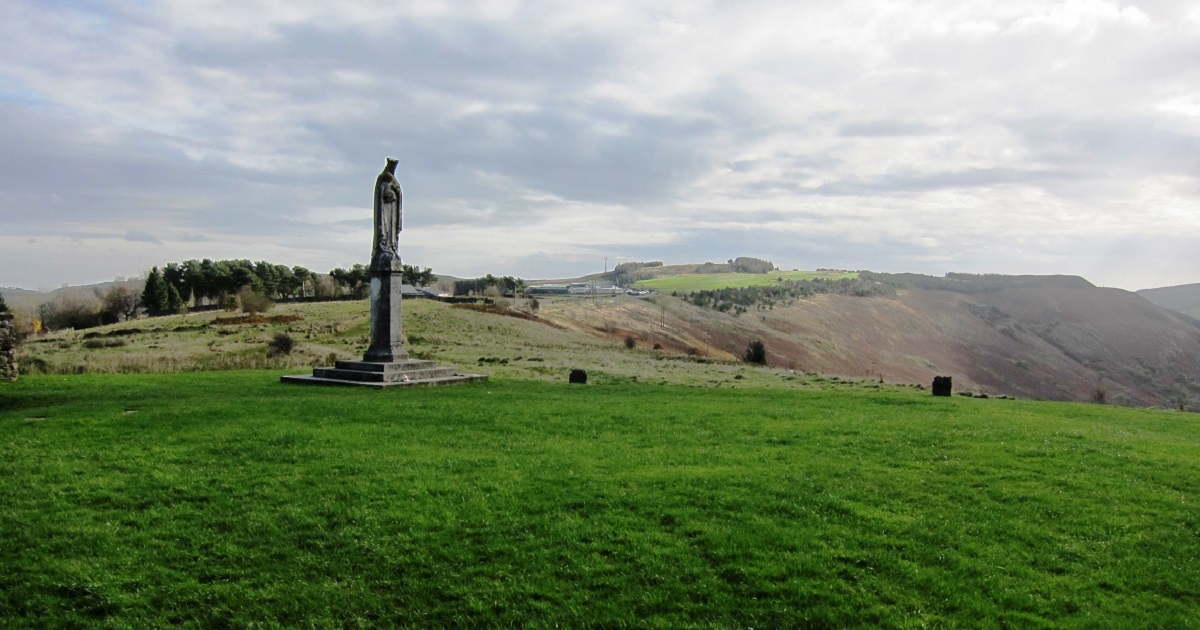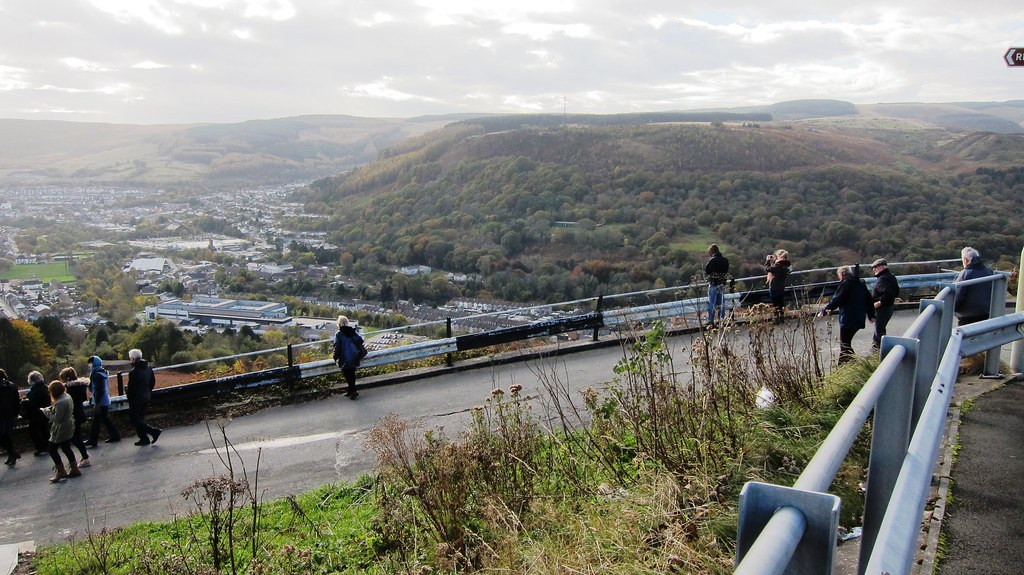Penrhys: the path of the pilgrim

Continuing our autumn series by John Geraint, author of ‘The Great Welsh Auntie Novel’, and one of Wales’s most experienced documentary-makers. ‘John On The Rhondda’ is based on John Geraint’s popular Rhondda Radio talks and podcasts.
John Geraint
You may know the name ‘Penrhys’. It’s a place that’s weathered storms and emerged as something of a model community, a skyline village way above the Rhondda. There’s a joke we used to crack when I was a boy: why is Penrhys the highest mountain in the world? Because it’s above The Star! I know, it’s the way I tell them, isn’t it?
But Penrhys has another claim to fame – one that doesn’t depend on the name of the old pub at the bottom of the hill, one that goes back hundreds and hundreds of years. I wonder if you know the full story? It’s a bit of a thriller…
Ten years ago, I produced and directed a TV series presented by Huw Edwards: The Story of Wales, the whole history of our nation, from 30,000 years ago to the present day.
We did a fair amount of filming in the Rhondda – how could we ignore the Valley’s central role in the crowning of King Coal, the industry that defined and shaped modern Wales? But there was much older tale I was also determined to tell. And with the help of historian Professor Madeleine Gray that’s what we did.
We focused on an incident that happened on Penrhys when Henry VIII was on the throne. Back then, the whole population of Wales would have been smaller than modern-day Cardiff’s. Cardiff scarcely existed.
There were some towns – Carmarthen, Haverfordwest, Brecon, Wrexham. But the vast majority of people were farming in places like the Rhondda, living in – and off – the land. Nine out of every ten of them didn’t speak or understand any English.
Most of them never had the luxury of travelling far from their own parish. Their lives were lived in a tight locality – y filltir sgwar, their own patch – something that’s still so important in many parts of Wales.
Families were large, but disease and food shortages meant many children never lived to be adults. In the teeth of hardship and tragedy, people held fast to traditional beliefs.
Faith
The Welsh were devout Catholics, known across Europe for their devotion to the Virgin Mary. Their Christianity sat alongside the faith they had in more ancient rites and rituals, like the healing powers of holy wells and springs.
But a big change was coming, driven by Henry VIII’s ambitions – and his sex life. Henry’s desire to annul his marriage to Catherine of Aragon, his brother’s widow, sparks a break with the Pope in Rome. Henry uses the split to get his hands not just on a new wife, but also on money and property – and lots of it.
He seizes the wealth of the monasteries, which for centuries had been pillars of Welsh life, chronicling our history, counselling our princes, sponsoring our poets. Henry’s avarice suits those Protestants who’re determined to smash Catholic practices in Wales.
They target six key sites sacred to the Old Faith. One of them is Penrhys. But Henry’s enforcer, Thomas Cromwell, knows that they’ll need to move very carefully. This is one of the holiest places in Wales.
Pilgrims
For centuries, pilgrims had been coming to Penrhys across land and sea, according to the poets. They came to bathe in the waters of the holy well, expecting to be healed or blessed.
The Cistercian monks of Llantarnam in Gwent had an outlying sheep farm or grange on Penrhys, and by the fifteenth century there were three large buildings here: the well, a chapel, and a hostelry – the first pub in the Rhondda, I suppose. It was a place for the increasing numbers of pilgrims to stay.
Because Penrhys was also home to a wooden statue which had appeared in an oak tree here as if by a miracle: a statue of the Virgin Mary bending over to kiss the baby Jesus in her arms. She’s the Queen of Heaven.
But she’s also an ordinary peasant woman, giving her child a cwtsh. I’m sure that’s what spoke to the ordinary people of the Valley: she was one of theirs, a woman of the Rhondda.
Miracles
By Henry VIII’s time, the pilgrimage to Penrhys had become hugely popular. Miracles were said to happen there. It’s easy to look back now and write that off as superstition.
At the time, it was a conviction that ran right through society, from kings and queens down to the poorest peasant – the belief that if you travel to somewhere where holy things have happened, good things can happen to you.
But for the Protestant reformers who’d been empowered by Henry, beliefs like these are not just superstitious – they endanger national security. Catholics are viewed – potentially, at least – as traitors.
For Thomas Cromwell, it’s a political priority to destroy shrines like Penrhys, to break the hold they have on people’s faith. No matter how beautiful they are, no matter how much they’re loved – in fact, precisely because they’re beautiful, and people love them.
So, in the summer of 1538, Cromwell writes to the son of the Sheriff of Monmouthshire, William Herbert, of St Julian’s in Newport and orders him to ride to Penrhys. He’s on a mission to destroy the shrine. When he arrives, there’s a stand-off.
Local people gather, reluctant to let this outsider snatch the statue they venerate. Herbert needs to impress on them all the authority he’s been given by the Crown.
What he says in his report to Thomas Cromwell is along the lines “I explained to them what they were doing wrong, how they were dishonouring the King and God. And I took the statue away.” End of story! Not quite.
The strange thing is that it takes William Herbert three weeks to write up his report. And when he writes it, he has to admit that the statue is still in his house in Newport. What is it doing there? That statue is hot! It could spark a rebellion. What’s he doing with it in his house?
Magic
Was William Herbert a Catholic sympathiser? In an era when Catholics’ loyalties highly were suspect, he did arrange to marry his son into one of the foremost Catholic families of Monmouthshire.
But if Herbert is having second thoughts about Penrhys’s miraculous statue, the reality is that Cromwell is far too powerful a man to be denied.
The wooden statue is eventually sent to London. At Tyburn – the place where traitors are executed – the statue is burnt to cinders.
The shrine is destroyed, the pilgrimage stopped.
The well, of course, doesn’t dry up. People keep using it. They say it’s good for helping their butter to churn. And traditions about the spring endure.
You can go to Penrhys and find there’s plenty of water. You can go there and find hardly any water at all. The locals say it flows when it wants to. So there is still something about the place, despite Thomas Cromwell’s determination to erase all memory of its magic.

Mysteries
The stone statue of the Virgin and her Christ-child which stands up above the well nowadays is proof that Cromwell didn’t completely succeed.
For Catholics, Penrhys’s miraculous associations with Mary put it technically on par with shrines like Lourdes and Fatima, places that attract millions of pilgrims from all over the world.
So Penrhys has always been recognised. In recent years, its national significance has been reasserted with the opening of the Penrhys Pilgrimage Way as a walking route all the way from Llandaff Cathedral in Cardiff.
To me – born, like thousands of other Rhondda people, in a hospital on the mountainside just below the little chapel and the spring – Penrhys has always been somewhere I love to go; to look down on my Valley, to look across to Mid-Rhondda, to look up towards Treorchy.
People have been coming here for centuries, thoughtfully, reverently, to ponder the deep mysteries of life, in the hope of better things to come.
And that, for me, irrespective of anything else that might be true about the place, makes Penrhys very special indeed.
John On The Rhondda’ is broadcast at about 3.15pm as part of David Arthur’s Wednesday Afternoon Show on Rhondda Radio
All episodes of the ‘John On The Rhondda’ podcast are available here
John Geraint’s debut in fiction, ‘The Great Welsh Auntie Novel’, is available from all good bookshops, or directly from Cambria Books
Support our Nation today
For the price of a cup of coffee a month you can help us create an independent, not-for-profit, national news service for the people of Wales, by the people of Wales.





What a great story, if it is historically correct , I would love to read more
Why do people use the present tense to describe something that happened on the past, it just sounds wrong
in the past I mean